DDA Parking Data: Better, Faster, Stronger?
Ann Arbor Downtown Development Authority board meeting (Dec. 5, 2012): The board had no voting items for its final meeting of the calendar year, but received several reports. Among the reports was a draft recommendation to be presented to the city council early next year about the use of five city-owned pieces of downtown land, which are currently used for parking – the Connecting William Street project. That presentation, discussion by the board, and public commentary on the topic will be covered in future Chronicle reporting.

Ann Arbor public parking system: monthly permit use by length of stay. An example of the kind of data that’s possible to track for the public parking system. The DDA board has requested that Republic Parking start including additional data in its monthly parking report.
The DDA manages the city’s public parking system, and a report presented to the board for October 2012 – the most recent month for which data is available – showed $1.675 million in revenue, which amounts to an increase in revenue compared to October 2011 of about 15.5%. The increase is at least partly a function of rate increases, changes to the billing method, and an increase in the parking system inventory. The recently completed Library Lane underground parking garage offers more than 700 spaces, which were not available a year ago. The use of the parking system as measured by hourly patrons showed only a 1.8% increase.
At the meeting, DDA board member Roger Hewitt announced that future monthly reports would begin including more detailed information on the length of time patrons park in the system. Currently the board uses revenue levels as a kind of imperfect proxy for system usage.
Also related to the parking system, the stats for November will include the fact that the parking system maxed out – with all spaces in the entire system filled – on the night of the Midnight Madness holiday shopping promotion. That’s an event sponsored by the Main Street Area Association (MSAA), which took place on Nov. 30. Maura Thomson, executive director of the MSAA, relayed her appreciation to the board during public commentary for the DDA’s financial support of the holiday lights strung on trees downtown.
Again related to parking were brief remarks made to the board by local attorney Scott Munzel, who spoke on behalf of the developer of the proposed new residential project at 624 Church St. The DDA board had given its support for around 40 parking spaces to be provided for that 14-story, 81-unit apartment building through the city’s contribution-in-lieu program. Munzel alerted the board that the project was anticipated to be on the city planning commission’s Jan. 15, 2013 agenda. Munzel was hoping the location of the parking spaces in the public parking system could be determined by then.
Ray Detter, speaking for the downtown citizens advisory council, updated the board on another major development – 413 E. Huron. The northeast corner of Huron and Division is the location of a planned residential and retail development with 213 apartments – which does not need any variances in the D1 zoning district. Detter reported the developer’s intention to proceed with the development even through it was strongly criticized by the city’s design review board.
Addressing the board on a non-parking topic was Jim Balmer, president of Dawn Farm, a nonprofit offering both residential and out-patient services supporting recovery for alcoholics and drug addicts. Dawn Farm’s Chapin Street facility has been supported in the past by the DDA, and Balmer addressed the board to thank them for that support and to highlight a future funding request – $150,000 to pay down debt. The grant is intended to help Dawn Farm achieve a target of 200 beds for its residential facilities, up from the current 159 beds.
The board received news that the preliminary draft audit report indicates that the fiscal year 2012, which ended June 30, 2012, will be unqualified – that is, “clean.” The unrestricted net assets held by the DDA at the end of the fiscal year totaled about $8.65 million.
Parking
As usual, parking was a dominant theme of the DDA’s board meeting.
Parking: Profit-Loss
Roger Hewitt gave the parking report. It included a profit-and-loss statement on each facility for the year ending June 30, 2012. [.pdf of profit-loss statements] The second to the bottom line, he noted, reflects whether a particular structure “made money or not.” The key to that is three lines above that bottom line – bond payments.
Four structures still have bond payments being made, he pointed out. The Fourth & Washington and the Fourth & William structures still have the original construction bonds that need paying off, he noted. Two other structures have related bond payments: Maynard and Forest – which both underwent significant renovations. Hewitt pointed out that even after the bond payments are factored in for Maynard and Fourth & William, they’re still making money – unlike Fourth & Washington and Forest.
Hewitt said the more significant point is not to evaluate whether an individual structure is making money but rather whether the parking system as a whole is working. And the net annual income is nearly $800 per space, Hewitt said. So net revenue from the parking system is anticipated to be about $5.6 million for last fiscal year.
Responding to a question from Sandi Smith, Hewitt indicated that the $5.6 million figure was after making the payment due to the city of Ann Arbor, for 17% of gross parking system revenues. The total paid to the city was about $3 million or roughly $300,000 more than was budgeted, Hewitt said. It also includes the rent paid to privately-owned parking lots the DDA uses.
Parking: Midnight Madness
Hewitt also reported on a unique occurrence that, depending on your viewpoint, was either good or bad, he said. The previous Friday night, on Nov. 30, was Midnight Madness – and it maxed out the parking system. At some point during Friday night, every single spot at every structure and surface lot was filled, Hewitt said. That had happened only once before – on the Friday of the art fairs this year. That’s nearly 5,600 spaces, he said. The two structures at Maynard and at Fourth & Washington had parking activity that would be the equivalent of filling and emptying four times, Hewitt reported. If the new Library Lane structure had not been on line, it would have been necessary to shut down the system for 2 hours at the beginning of evening. There were almost 1,500 more parkers entering the system between 5-8 p.m. than last year on Midnight Madness.
John Mouat ventured that more important than the parking numbers were the people who were downtown. Hewitt said: “There were a lot of people downtown Friday night!” He saw that reflected in his restaurant. [Hewitt owns the Red Hawk.] Hewitt thanked the Republic Parking staff for their work in getting people in and out as quickly as possible.
Leah Gunn added that based on a conversation with Maura Thomson, executive director of the Main Street Area Association, “business was booming.” People were not just walking around, Gunn said, they were buying.
Thomson also appeared before the board during public commentary time to thank the DDA publicly for the downtown holiday lights display. She felt it contributes to stimulating the downtown economy, and has an impact on the experience people have downtown that can’t be measured. It creates an environment that helps people feel connected to the downtown and makes people want to talk to other people about how great they think this downtown is, she said. As someone who works to promote downtown, she thanked the DDA for making her job easier.
Board member Nader Nassif responded to Thomson’s remarks by noting that he now lives on Fourth Avenue. He’d like to see the holiday lights expanded to other areas of downtown, not just Main Street. Sandi Smith echoed Nassif’s sentiments, calling it an easy piece of low-hanging fruit. Smith also suggested adding some wayfinding directions from the downtown to the Border-to-Border trail and the new Argo Cascades.
Parking: Monthly Report
The monthly parking report – comparing October 2012 against October 2011 – showed a 15.5% increase in revenue, with the number of hourly patrons up 1.8%. Hewitt pointed out that the new underground Library Lane structure showed about $77,500 in revenue, which he called “pretty good for a new structure.”
Hewitt indicated that the operations committee will be looking at the kind of statistics it requests from Republic Parking, the DDA’s subcontractor for parking operations. After adding the new Library Lane underground garage, the committee will be asking that Republic produce more detailed statistics on hourly users and how they affect the system. He said the format of the report would likely be modified to get a better idea of the impact of hourly users on the system.

Ann Arbor public parking system: Revenue. Compared to October 2011, revenue was up again (green trend line) – by 15% after showing about nearly the same revenue year-over-year in September. The revenue increase reflects increased rates, billing by the hour, and 865 additional spaces compared over the 6,955 in the system that were available in October 2011. It’s not clear how much additional usage of the system it reflects.
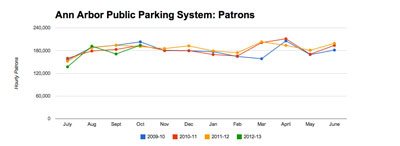
Ann Arbor public parking system: Patrons. Compared to October a year ago, the number of hourly patrons was up incrementally by 1.8%.
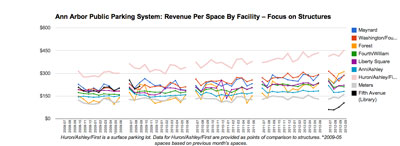
Ann Arbor public parking system: Focus on structures. The new Library Lane structure showed a clear upward trend in revenues per space (black trend line).
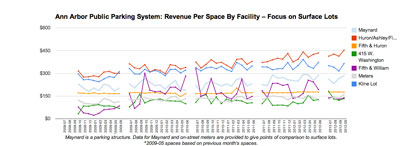
Ann Arbor public parking system: Focus on surface lots. The Fifth & William lot (purple trend line), near the newly opened Library Lane structure, may have lost some patrons to the new structure.
The different statistics that will be included in the standard monthly reports reflect an attempt to get a clearer picture of how different patrons are using the parking system. The DDA makes monthly permits available at prices that yield less revenue per space than the DDA would receive, if all spaces were paid at the standard hourly rate. For example, the standard hourly rate for a parking structure is $1.20 per hour. A standard monthly permit in some structures costs $145 per month. So a downtown worker who used a permit for eight hours daily would break just about even after three weeks, compared to paying hourly. [145/(1.2*8)]
The strategy the DDA is using to free up spaces for hourly patrons in structures near the University of Michigan campus has been to offer discounted permits in the new Library Lane structure – for new patrons or for people willing to shift their permits from Liberty Square or Maynard to the new Library Lane structure. That discounted rate is $95 per month. In the first week of December, 260 of the cheaper permits for Library Lane had been sold, with an additional 336 permits sold at the regular rate of $145 – for a total of 596 permits sold for the 738-space structure.
Revenue from permits alone for Library Lane would translate into about $73,000 per month. [336*145 + 260*95] Back in October, with fewer monthly permits sold, and about 8,000 hourly parking patrons using Library Lane, the structure generated $77,500 in revenue.
With additional statistics about how long hourly patrons are staying and how long monthly permit holders are parking, the DDA hopes to get a clearer understanding of the impact that pricing policies have on parking behavior.
Parking: Spaces for Bicycles
Two of the parking spaces in the Maynard structure will be given over to bicycle parking starting in March or April. John Mouat gave an update on the project, which getDowntown director Nancy Shore has suggested be called the “Bike House” – on analogy with the Big House, as University of Michigan’s football stadium is known.
Sketches and preliminary pricing has been done by designer Dan Mooney. At its Oct. 3, 2012 meeting, the DDA board authorized a $30,000 budget for the facility, which is expected to provide room for about 50 bikes.
Similar “cages” in other cities use a chain-link fencing material. However, the DDA hopes that a more aesthetically pleasing option can be identified. The preliminary drawings include a laminated glass half wall, instead of a chain-link design.
The facility is designed for commuters who would pay a rental amount for use of the “cage.” Bicyclists would still be responsible for securing their own bikes in racks inside the cage. [.jpg of rack configuration].
Development
A number of items on the Dec. 5 agenda related to the Ann Arbor DDA’s role as a development authority.
Development: Parking
Under city policy, the public parking system is used as a development tool – and that policy is implemented by the DDA. So local attorney Scott Munzel appeared before the board during public commentary time representing Opus Group of Minnetonka, Minn. – which is developing a residential project at 624 Church St. in downtown Ann Arbor. It will be a 13- or 14-story, 83-unit apartment building with approximately 181 beds. A request had already been made to the DDA by the developer to provide the required 40-42 parking spaces by contracting for them in the public parking system. That’s instead of building the spaces on site as part of the project.
The authorization to work out the parking agreement in the context of the city’s “contribution in lieu of parking” program came on a vote taken at the Oct. 3, 2012 meeting of the DDA board. The DDA manages the city’s public parking system under a contract with the city.
Ann Arbor’s “contribution in lieu of parking” program was authorized by the city council on April 2, 2012. That program allows essentially two options: (1) purchase monthly parking permits in the public parking system for an extra 20% more than the current rate for such permits, with a commitment of 15 years; or (2) make a lump sum payment of $55,000 per space. It’s option (1) that the 624 Church St. project will be pursuing.
At the DDA board’s Dec. 5 meeting, Munzel reported that the site plan for the project had been submitted and is expected to be on the Jan. 15 agenda of the Ann Arbor planning commission. Munzel ventured that the planning commission will want to know where the authorized spaces will be, and he told the board that the size of the building had settled in on a slightly smaller square footage, so that 40 spaces would be needed, not 42.
Munzel reiterated the developer’s request that those spaces be provided in the Forest parking structure, which is the closest one to the development. Munzel said that location would best meet the intent of the payment-in-lieu policy and would help stabilize revenue to the DDA. He offered to sit down and chat about that informally.
Development: Grant Request – Dawn Farm
Jim Balmer, president of Dawn Farm, told the board he guessed they all knew who he was, and that they’d seen the request that had been made for financial assistance to reduce the debt on two of the organization’s existing properties. By way of background, Dawn Farm is a nonprofit offering both residential and out-patient services supporting recovery for alcoholics and drug addicts. In 2001, the DDA had made a $135,000 grant to Dawn Farm to assist with the purchase of the property at 112 Chapin St.
The current request being made to the DDA is for $150,000 to help pay down the debt on two other Dawn Farm properties, at 343 Beakes and 324 Summit. The grant from the DDA would free up cash to expand the existing total 159 beds in Dawn Farm’s residential treatment facilities to 200 by early 2013, according to Dawn Farm.
Development: Update on 413 E. Huron
Reporting from the downtown citizens advisory council, Ray Detter told the board that in recent weeks, representatives of the eight downtown and near-downtown residential neighborhood associations had been negotiating directly with the developer of the project at 413 E. Huron St., which Detter described as a “massive 14-story … student housing building.” It’s located just east of Sloan Plaza and immediately adjacent to the Old Fourth Ward historic district.
Greenfield Partners is a financial backer of the project, Detter said. They have rejected all suggestions and requests from the city’s design review board to improve the design of the building, he reported. The design review board had recognized that context is important, and that the project is part of a specific character area, Detter said. [The city's development process of design review is mandatory, but compliance with the recommendations of the design review board is voluntary.] According to Detter, Greenfield Partners said that any further changes would affect the profitability of the project. The bottom line, Detter continued, is that the developer wants to make the maximum he can. “They call it ‘by right’ and they’re going to build it to make that money…”
Detter expressed some optimism based on the draft recommendations from the Connecting William Street project. A draft indicates that the planning commission would be required to report to the city council about how a project team responded to the recommendations of the design review board. The downtown citizens advisory council will join with other groups to work toward improving the design review process for all buildings, he said, not just those on public property.
Development: Board Retreat
Susan Pollay, executive director of the DDA, summarized the recent board retreat that was held on Nov. 17. The board had talked about the basics and what DDAs are created to do. They’d talked about what the board felt the Ann Arbor DDA did well and what outside stakeholders felt they did well, as well as what they did not do as well. A smaller group of the board had met after the retreat, she reported, and distilled the discussion from the retreat into key tactics:
- Identity. There’s a lot of information that’s currently captured by the DDA about the downtown. More efforts could be made along these lines, Pollay said.
- Infrastructure. It’s what the DDA is known for. The walkability and attractiveness of downtown is due in large part to DDA dollars, she said.
- Transportation and parking. There’s more the DDA could do to merge the two areas. The DDA needs to look at the results of the Connector Study [on the corridor between US-23 and Plymouth, through University of Michigan campus and downtown to I-94 and State].
- Business encouragement. The DDA should include a focus on “clean and safe” and should make conversations with the Main Street business improvement zone (BIZ) a part of that – which would help tap into the private sector.
- Housing. It’s a key ingredient of the DDA’s success, Pollay said. The city and Washtenaw County, as well as the nonprofit community, have a role to play, she added. The DDA’s specialized role could be in supporting work-force housing. The DDA is trying to make it possible for people to live and work in the downtown.
Audit
Roger Hewitt reported that the operations committee had received a draft of the audit. The final version hasn’t been received yet, but he said it was completely clean as an accurate reflection of the DDA’s financial condition.
The statements include total net assets of $8,767,926 – nearly a $1 million increase over the previous year. That is primarily held in the balances of the DDA’s four different funds: TIF – tax increment finance ($4.7 million), parking ($2.1 million) and the two combined funds of housing and parking maintenance ($1.7 million). For the formal audit, the housing fund and the parking maintenance funds are lumped together as “non-major governmental funds.”
Bike Share
DDA board member John Mouat briefed his colleagues on a bike-share program that the DDA is being asked to support. A bike-share program would allow members to take a bicycle from a station and use it for a period of time. The concept is that several stations would be placed in a geographic area, so that a bicyclist could, as much as possible, ride from one station to another.
By way of background, a year ago – at the DDA’s Dec. 7, 2011 meeting – Mouat had briefed the board on a request from the Clean Energy Coalition for in-kind support for the bike-sharing program. The bike-sharing program would work on analogy to car-sharing programs like Zipcar. The initial request for only an in-kind contribution from the DDA was based on the hope that a grant award from the Federal Transit Administration’s Congestion Mitigation and Air Quality Improvement (CMAQ) would cover both capital costs and operations. But it turns out that the FTA has limited the program to capital costs only.
At the partnerships committee meeting of June 27, 2012 the grant request by the CEC to the DDA was described as $5,000 in calendar year 2012 and $10,000 annually for the three years from 2013-2015. Other organizations that had been asked to contribute financially include: the Ann Arbor Transportation Authority ($18,000 this year and $40,000 annually for three years); the city of Ann Arbor ($15,000 this year and $40,000 annually for three years; and the University of Michigan ($66,000 this year and $200,000 annually for three years). The university was described as contributing the lion’s share because UM is interested in controlling the advertising component of the program.
At the board’s Dec. 5 meeting, Mouat described the project as having “run into a speed bump.” The CEC is looking to increase the amount of the requests. The question of how to ensure adequate operating expenses is crucial. Mouat indicated that his inclination was to put as much as possible of the responsibility on the University of Michigan. He described it as a complicated issue.
At the operations committee meeting of the DDA the previous week, Mouat had reported that the most recent meeting of the potential partners had become a bit contentious. At that operations committee meeting, DDA executive director Susan Pollay had supported the idea of having the University of Michigan take the lead with a launch that would be confined to the campus. When the program was established, it might be expanded – roughly on analogy with the way that the Zipcar program was rolled out in Ann Arbor.
The city of Ann Arbor is represented in the bike-share discussions by Eli Cooper, the city’s transportation program manager who also serves on the AATA board. In a telephone interview with The Chronicle, he indicated that he hoped the initial deployment would not be confined only to the University of Michigan campus. He pointed out that the concept of a bike-share is actually different from Zipcar.
When a patron of a Zipcar uses a vehicle, then the expectation is that the driver will use the vehicle for some period of time, perhaps driving somewhere and parking it for an hour or two, then returning it to the same Zipcar parking space. A bike-share program, in contrast, depends on the availability of a station near the intended destination, so that a user pays for the time of the travel, not for the entire “outing.” So Cooper hoped that the initial geographic deployment of stations would be as broad as possible. Cooper stressed that one of the challenges is that bike-share as a transportation strategy is relatively new.
Misc. Communications
The DDA board’s meeting included a range of other comments and communications.
Comm/Comm: Calendar
The board decided to move its January 2013 meeting to Jan. 9. Ordinarily it would have fallen on Jan. 2.
Comm/Comm: Thank You
Susan Pollay, executive director of the DDA, addressed the board at the end of the meeting during the public commentary time, saying she was wearing her citizen of Ann Arbor hat. She thanked DDA board member Sandi Smith for her tenure as a city councilmember. This year, Smith chose not to seek another two-year term after serving four years representing Ward 1 on the council.
Pollay also thanked DDA board member Leah Gunn, who was going to attend her final session of the Washtenaw County board of commissioners that night.
Comm/Comm: Adopting a Theme
Addressing the board at the conclusion of the meeting was Thomas Partridge. He encouraged the board to adopt a freedom theme for the 21st century. He called for the Ann Arbor Transportation Authority to provide transportation under the theme of Freedom Rides. Ann Arbor hasn’t adopted a theme and has been scooped by other cities like Atlanta, San Francisco, Chicago, New York, and Boston, he said. He criticized what he described as the Caucasian dominance of elected and appointed boards in Ann Arbor.
Present: Nader Nassif, Bob Guenzel, Roger Hewitt, John Hieftje, John Splitt, Sandi Smith, Leah Gunn, Russ Collins, Keith Orr, Joan Lowenstein, John Mouat.
Absent: Newcombe Clark.
Next board meeting: Noon on Wednesday, Jan. 9, 2013, at the DDA offices, 150 S. Fifth Ave., Suite 301. [Check Chronicle event listings to confirm date]
The Chronicle could not survive without regular voluntary subscriptions to support our coverage of public bodies like the Ann Arbor Downtown Development Authority. Click this link for details: Subscribe to The Chronicle. And if you’re already supporting us, please encourage your friends, neighbors and colleagues to help support The Chronicle, too!




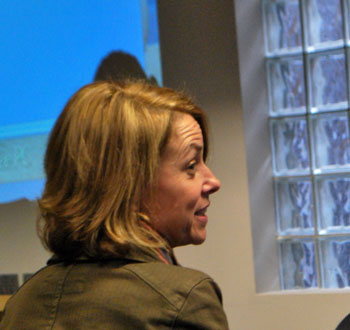
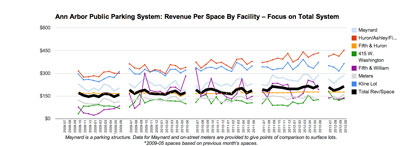
Before embarking on high-cost, high-visibility, low-benefit projects like bike lockers and bike sharing, I wish the DDA would give us the basics. Bicycle parking in the downtown area is laughably inadequate and getting worse. The parking structures each have only half a dozen or so bike parking spaces compared to hundreds of car parking spaces. Many of the spaces are unusable due to poor design, like the ones at Fourth & William that are not on level ground, or the ones at Maynard that are too close together, too close to surrounding obstructions, and always full of abandoned bikes. City Hall used to have a couple dozen covered spaces right by the front door. Now it’s only got a few spaces, and they are not adequately covered.
We also continue to require landlords to supply car parking, but not bike parking. Yes I know there’s a law, but for some reason it’s been ineffective.
A bike sharing program is good for headlines. Providing good bike parking doesn’t get headlines, it just benefits ordinary people who want to bike to work. It seems to me the DDA is more concerned with appearances than actually doing good.
“The statements include total net assets of $8,767,926 – nearly a $1 million increase over the previous year.”
Dave, do you know how the DDA has those funds invested? If they’re not properly protected (preferably in cash at a sound bank or in short-term US treasuries), they could take a drastic hit in the coming downturn.
Am I the only one who sees a disconnect between the policy of allowing developers to purchase in-lieu parking, the max-out of the system on at least one busy night, and the plans to remove several open lots from the parking system? Meanwhile, the rates keep going up.
Frankly, I have simply given up going downtown for most events because of the difficulty in parking. I would take the bus, but my route does not have evening and weekend hours. I’m a little too far (about 2 miles) to walk for entertainment or for dinner.
I doubt most residents are perceiving an excess of parking spaces. So why are we getting rid of them?
@3: Because residents are irrelevant, especially if they don’t go (or live) downtown. Keep in mind that the DDA is not our elected city council. In that sense, there’s no disconnect–it’s never been about more parking. It’s about a lively downtown for people with money to spend.
It’s an unaccountable hijacking boondoggle and a scourge on the good citizens of Pleasantville. And we’re getting restless.
@5: It’s not unaccountable. The mayor appoints and serves on the board. Whether it’s a boondoggle is debatable.